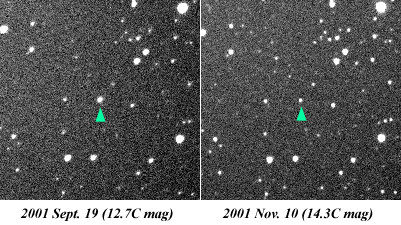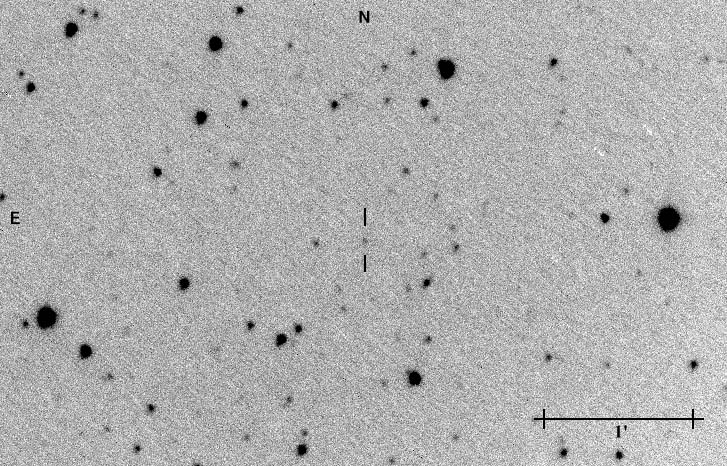Japanese version Home Page Updated on November 9, 2002
November 9, 2002MisV1181: Our First Nova DiscoveryMISAO Project Announce Mail (November 9, 2002) Hello. I am Seiichi Yoshida working on the MISAO project. On October 27, 2002, we the MISAO Project discovered our first possible nova, MisV1181. As is often the case with amateur's discovery of a nova or new comet, it came to be regarded as a possible nova after many twists and turns. And many people kindly helped us in the process. Here we introduce how MisV1181 was discovered and announced as a possible nova. MisV1181 is a possible nova in 2001 discovered by John Greaves, Seiichi Yoshida, Nobuo Ohkura and Ken-ichi Kadota in collaboration. It locates in Cepheus, at R.A. 22h58m09s.12, Decl. +66o21'12".4 (equinox J2000.0). It was 12.7 mag on the images taken by Nobuo Ohkura on Sept. 19, 2001, but faded to 14.3 mag on the images on Nov. 10, 2001. Toshikazu Muramatsu observed it recently, and it is already so faint as 20 mag. 
MisV1181 in 2001 (Image: Nobuo Ohkura) 
Light curve of MisV1181 This object, MisV1181, was picked up as one of the new variable star candidates in the bright new object survey for Nobuo Ohkura's images. In the course of the MISAO Project, we operate two types of surveys for offered images. One is the new variable star survey, that is, to search variable stars while comparing images with those of the same field on another night. Most of the MISAO Project new variable stars have been discovered in this survey. Another one is the bright new object survey, that is, to list up bright stars not recorded in the USNO-A2.0 catalog, checks the past DSS (Digitized Sky Survey) images, and search new objects. The possible nova was discovered in the bright new object survey by Seiichi Yoshida using the PIXY System 2. It may sound natural that a possible nova was discovered in the bright new object survey. However, I did not recognize at first that it is a possible nova, due to one accident. This object was not found on the DSS images. But the PIXY System 2 output that there is an infrared object IRAS 22562+6606 very near by this object. An infrared object often becomes very faint on photographs, so it is common that not found on the DSS images, or not recorded in the USNO-A2.0. On the other hand, it often becomes very bright on CCD images because the CCD chips are sensitive in infrared. In addition, the position of an IRAS object has a large error around several dozens of arcsec, or about one arcmin. Therefore, I have been paying no attention when an IRAS object exists closely, even if the star is not found on the DSS images. In the case of this object, I did not, either. But it had a possibility to be a new Mira type variable star. So I decided to search other images in the MISAO Project database. When I searched the database, I found that this object is also found on the images on Nov. 10, and the brightness changed between September and November. However, I believed it to be a red variable at that time. In this bright new object survey, I found nine new variable star candidates totally, including this object. On Oct. 13, 2002, I requested Ken-ichi Kadota for final confirmation. I also requested Taichi Kato and John Greaves for catalog research. Immediately, I received a reply from John Greaves. He researched the GSC 2.2 catalog, DSS images, etc., and found this object is not found in any catalogs and images. He also commented that the IRAS 22562+6606 seems to be too far from this object. But at that time, he suspected the measured position by the MISAO Project may be erroneous. This object and IRAS 22562+6606 lie north and south with about 1 arcmin distance. But IRAS 22562+6606 has a 44 arcsec position error in north and south direction. Therefore, I still believed that this object and IRAS 22562+6606 are the same star, and it is a red variable. However, John Greaves came to suspect that it may be a nova or so, because it is not found on DSS images. Then he investigated the Palomar plates at: USNO Flagstaff Station Finder Chart Service Now, another accident changed his mind from a possible nova to a possible cataclysmic variable. This object is not found on any Palomar plates, except for one. But on one plate in 1952, there is a star image at the position, about roughly 19 mag. Around that time, Arne Henden observed this star in request of John Greaves. The sky condition was poor, but he succeeded to capture the image of this object. The brightness was roughly around 19 mag. They imply that the object returned to be the original brightness in only one year after the outburst, if it is a nova. It seems strange as a nova. So John Greaves changed his mind that this object is probably a cataclysmic variable, normally around 19 mag, and rarely bursts out. Receiving those information from John Greaves, I also investigated the DSS images by myself. Then I found that it is not found even on the DSS-2 infrared images, where a red variable must be bright. Now I recognized it is not a Mira type star, but a remarkable one. And I requested my friends for observation by e-mail in the evening on Oct. 25. On that night, Toshikazu Muramatsu observed it with 0.65-m reflector at Hoshinomura Observatory and sent me the images. The object was found on his images at 20 mag. 
MisV1181 on Oct. 25, 2002 (Image: Toshikazu Muramatsu) I also investigated the Palomar images by myself, as John Greaves did. I compared Toshikazu Muramatsu's images with the Palomar image, the only one in 1952 on which there is a star image at the position. Then I found that the Palomar image actually shows quite different place in the sky. That means, this object is a real new one, not found on any past images. 
Palomar plate in 1991 Revealing the Palomar plate in 1952 was erroneous, John Greaves also became to believe that it is a possible nova. Finally, after Ken-ichi Kadota's final check, we assigned the number "MisV1181" to this object, the 1181st new variable star of the MISAO Project, and announced to the public on Oct. 27. After announcement, Akira Takao sent me the images of the field on Sept. 16 and 17, 2001. MisV1181 is around the edge of the wide field images. But MisV1181 was not found. Akira Takao reported it was fainter than 12.3 mag. Mike Collins also reported that MisV1181 was in the field of his photos on June 28 and Oct. 8, 2001, but MisV1181 was fainter than 13.0 mag and not found in both photos. Now, on Nov. 9, 2002, there are images on only two nights of MisV1181 in bright state. We request examination of archival images or photographs of this area in 2001 autumn. Finally, we received kind advice from many people not described in this report. We appreciate very much.
P.S. http://www.aerith.net/misao/variable/MisV1181.html The past MISAO project announce mails are available at: http://www.aerith.net/misao/ -- Seiichi Yoshida comet@aerith.net http://www.aerith.net/ |
